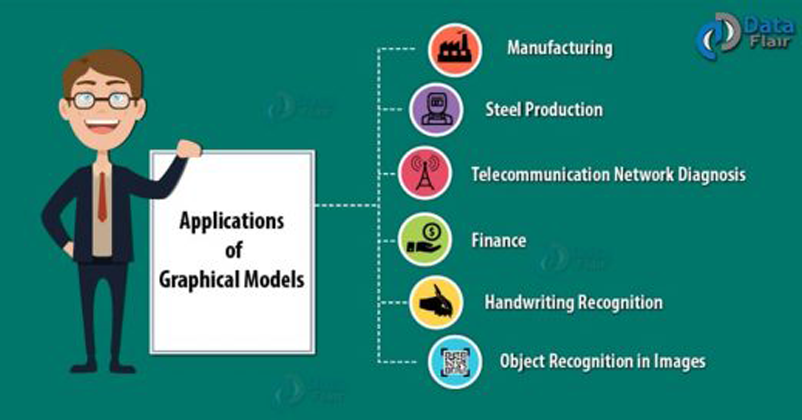Real-world Graphical Models Applications [Case Study Included]
FREE Online Courses: Enroll Now, Thank us Later!
Earlier we discussed, a detailed guide on Graphical Models. Moving ahead in our R DataFlair tutorial series, today we are going to discuss the various Graphical Models Applications in real life such as – Manufacturing, Finance, Steel Production, Handwriting Recognition, etc. The amazing part of this Graphical Model Applications article is the case study which you will find at the end of this blog. This R Case Study will help you like anything. Let’s start.
Graphical Models Applications in Real Life
R consist of mainly 6 Graphical Models Applications which are discussed below:
1. Manufacturing
Graphical Models has its applications in Manufacturing field. Making the production of low cost and most reliable components at a high quality is possible. This is possible if all components of a production system (i.e. machine tool operation, dispatching, etc) work on optimized parameters. These optimized parameters can be computed by using graphical models.
2. Finance
Graphs are visual representations. Using graphs, we can present the appropriate information of finance. In order to present the financial information, we require a discreet knowledge of the contents of operation as well as the receiver of the operation.
Have you checked the real-life applications of R?
3. Steel Production
To calculate the emission of carbon dioxide for Steel’s deoxidation we use Graph model.
4. Handwriting Recognition
We can use Graphical models to recognize handwriting. It can also use in several applications. It uses handwriting for identification.
5. Telecommunication Network Diagnosis
We use Graphical models for diagnosing issues in it. It is used to help and to resolve them.
6. Object Recognition in Images
Graphical models provide a powerful framework for encoding. It provides the statistical structure of visual scenes. It also provides facilities for the development of corresponding learning and inference algorithms.
Before moving ahead you must know how to save graphs to files in R.
To understand more in Graphical Models Applications, let us take a Case Study of Volkswagen.
Case Study – Graphical Models Application at Volkswagen
Let us see the application of graphical models at Volkswagen:
a. Background
The Volkswagen Corporation- It offers each customer the option of configuring their cars individually. A customer may choose from a wide variety of options which leads to high demand for logistics.
b. Problem
Attempting to achieve an ideal situation in which the customers provided with customized products built can be done by using components that arrive ‘‘just-in-time’’ for assembly, so that no stock is necessary at all. For this to be possible, it is necessary to plan the production process with high precision. This requires the most accurate prediction of the supply of the components.
c. Solution
- Volkswagen adopted the idea that given certain properties others may select independently of each other. Thus making decomposition of the joint probability distribution possible.
- Based on this decomposition, Volkswagen estimated the frequency of relevant combinations of properties. The system assumed that all cars in the sales database had these combinations.
- With this decomposition, Volkswagen was able to neutralize restrictions that involved individual configurations. So, enlarge the samples that could check because of the decomposition.
- Finally, Volkswagen is able to compute the supply of individual components from these estimates.
- To build the graphical model, Volkswagen created a relational network based on a catalog of technical and marketing rules. Volkswagen created it to describe constructible cars.
Don’t forget to check the data visualization concept in R
To create the relational model it needs 3 steps:
- Translate the catalog of technical and marketing rules into a relational representation. Represent all rules that refer to the same set of attributes by a relation over this set. Starting from the Cartesian product of the attribute domains, discard all tuples that are incompatible with one of the rules.
- Organize these relations in a lattice structure defined by the subset relation on the domains of the relations. Use the maximal elements of the resulting lattice as the maximal cliques of the graph of a relational graphical model. The relational model can be converted into a unidirectional graph through a consideration of the relational model’s graphical structure.
- Turn the relational model into an undirected graphical model by taking the graph structure of the relational model. Estimate and enhance it with probabilistic distribution functions, from a sales database.
Summary
Here we conclude our tutorial on Graphical Model Applications. In this article, we took a brief look at various different real-life applications in Graphical Model and a case study on Volkswagen. So this was all on Graphical Models Applications in R. For now, you must go through our next blog on R – Graphical Analysis.
Hope the information provided was useful to you. If you found any problem related to these Graphical Models Applications, do let us know by leaving a comment in a section given below. We will be more than happy to solve your doubts.
Your opinion matters
Please write your valuable feedback about DataFlair on Google


